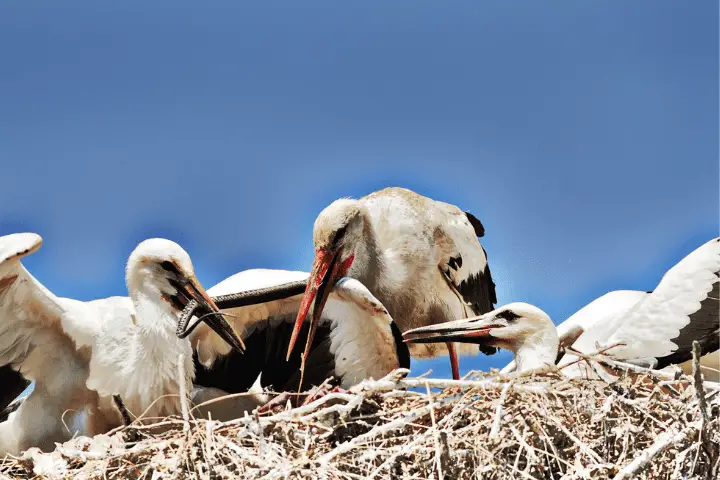What Birds Eat Snakes
Birds soar through the sky, sing sweet tunes and display alluring plumage. But did you know some birds have a taste for snakes?
Yes, you heard that right! Snakes are not safe, even from above. Birds are known for their varied diet, and they can be quite powerful predators.
In the natural food chain, birds are both predator and prey. We usually think of birds as eating insects, seeds or small mammals.
But some species have taken to hunting snakes! Different factors play a role in this behavior, like where the birds live. In areas with many snakes, like wetlands or grassy plains, birds have adapted to add these reptiles to their meals.
The Secretary bird is one such remarkable avian predator.
It has long legs and a sharp beak, making it capable of stunning and killing even venomous serpents. It uses its wings for balance and agility, so it can swiftly stomp on its prey before eating it.
In Africa, the African Harrier-Hawk has also evolved to include snake-eating in its diet. With its long legs, it can reach into crevices to extract serpents.
Birds are the original snake charmers, with an appetite for these slithery creatures.
Predatory Birds and Snakes
Predatory Birds and Snakes are Inextricably Connected in Nature
Predatory birds and snakes form a fascinating relationship in the wild. Here are four points that shed light on this intriguing connection:
- Predatory birds, such as hawks and eagles, have developed a strong hunting instinct, making them proficient predators in their ecosystem.
- Snakes, on the other hand, are a preferred choice of prey for many predatory birds due to their abundance and vulnerability.
- The hunting strategy of predatory birds involves spotting snakes from above and swooping down with incredible speed and precision to capture their prey.
- Interestingly, some birds of prey have evolved specific adaptations, such as sharp talons and keen eyesight, to effectively target and capture snakes.
Moreover, it is worth noting that this relationship between predatory birds and snakes goes beyond mere survival tactics.
It plays a crucial role in maintaining ecological balance by controlling snake populations and preventing them from becoming overpopulated.
Raptors and Snakes: A Strategic Battle
Raptors and Snakes do battle, exhibiting their strategic skills in the wild. With their own set of adaptations, these predators traverse through a complex ecosystem to survive.
| Raptors | Snakes |
| Razor-sharp talons | Venomous fangs |
| Acute vision | Hypnotic patterns |
| Aerial attacks | Ambush tactics |
These predators have varying strengths that shape their battle tactics. Raptors use their talons and vision to hunt from above, while snakes rely on venomous fangs and mesmerizing patterns to ambush prey.
This competition for survival has made them formidable hunters with amazing adaptability.
In this duel, life and death intertwine. Raptors fly above, surveying the ground with sharp eyes. Snakes slither below, using camouflage to stay hidden from raptors.
Each predator refining their special methods to evade capture or become better hunters.
Nature’s battles are incredible to witness in various ecosystems. Raptors and snakes are part of a complex web of interdependence, each species critical to the balance of nature.
Research published in the Journal of Animal Ecology has found that some snake breeds have developed special strike behaviors that can predict the movements of raptors.
Techniques Used by Birds to Capture Snakes
Birds are adept predators when it comes to capturing snakes. They use various techniques, such as pincer movements, dive bombing, talon grips, beak strikes, swooping grabs, and even ambush tactics.
Moreover, birds have exceptional night vision and specialized beak shapes that allow them to pry open the jaws of venomous snakes without getting bitten!
An amazing example of bird prowess is when a red-tailed hawk descended towards a rattlesnake with lightning speed and snatched it up in its talons before it could even react.
The agility and precision of these predators is truly remarkable.
Birds that Eat Snakes
- Specialized Beaks: Certain bird species, such as hawks, eagles, and kestrels, possess sharp, hooked beaks that enable them to tear through the tough skin and scales of snakes effortlessly.
- Aerial Agility: Raptors like kites and falcons display remarkable aerial prowess, ambushing snakes in mid-air or engaging in acrobatic chases, allowing them to swiftly neutralize their serpentine prey.
- Constrictor Confrontation: Some birds, including secretary birds and herons, possess the uncanny ability to deliver strong, lethal strikes at serpents using their long legs. They stomp repeatedly on the snakes until they are no longer a threat.
- Venom Conquered: Certain birds, like the mongoose bird, have evolved an immunity to snake venom. This advantageous adaptation allows them to consume venomous snakes without any harm.
- Cooperative Strategies: Some bird species, such as puffbirds and bee-eaters, employ cooperative hunting techniques when pursuing snakes. They work together to increase their chances of capturing and devouring these elusive reptiles.
Additionally, the avian diet is not solely restricted to snakes but also includes various other prey like rodents, lizards, and fish. Their hunting tactics and snake-eating behavior continue to fascinate researchers and wildlife enthusiasts alike.
Secretary Birds
Secretary Birds are one of the world’s tallest bird species, reaching up to 4 feet tall. They have long legs and beaks that help them hunt and catch prey, mostly snakes and other reptiles.
Unlike many birds that fly to catch food, Secretary Birds hunt on foot. Using their speed, they stomp on the snakes to stun or kill them, then eat them. As well as hunting snakes, these birds also hunt insects and small mammals.
On their foraging trips, they can cover up to 20 miles per day.
These birds are native to sub-Saharan Africa, but can survive in grasslands and savannas.
Another amazing thing about Secretary Birds is their strong kicks with their long legs, which helps them defend themselves from predators.
Roadrunners
Witness the power of the roadrunner! These incredible birds are known for their remarkable speed, capable of reaching up to 20 miles per hour.
With strong legs and feet adapted for running, they swiftly navigate through their habitats. But they’re not just fast runners; they’re also excellent fliers, capable of short bursts of flight when necessary.
They have a varied diet, eating insects, small mammals, lizards, snakes, and even other birds. They’re also highly adaptable, thriving in environments ranging from deserts to forests.
Amazingly, they possess specialized glands near their eyes that help them excrete excess salt due to their arid regions.
Behavioral Adaptations of Birds that Eat Snakes
Birds that eat snakes have developed unique behavioral adaptations to successfully hunt and consume their prey. These adaptations allow them to overcome the challenges associated with capturing and consuming snakes.
| Adaptation | Explanation |
|---|---|
| Hunting Techniques | Birds use various hunting techniques, such as aerial attacks or stealthy approaches, to capture snakes. |
| Powerful Beaks | These birds have strong and sharp beaks that enable them to puncture and penetrate the tough skin and scales of snakes. |
| Immunity to Venom | Some bird species have developed immunity or resistance to snake venom, allowing them to safely consume venomous snakes. |
| Swift Swallowing | To avoid potential counterattacks from snakes, birds that eat snakes have developed the ability to swiftly swallow their prey whole. |
| Camouflaging Plumage | Certain bird species have evolved plumage that mimics the appearance of snakes, allowing them to deceive their prey and approach undetected. |
| Nesting in Safe Locations | Birds may choose to build their nests in hard-to-reach locations, such as high tree branches or cliffs, to protect their vulnerable chicks from snake predation. |
| Alertness and Agility | These birds have enhanced sensory perception, enabling them to detect and react to the presence of snakes quickly. They also possess superior flight agility, which helps them evade potential attacks. |
It is fascinating to note that some bird species exhibit all these adaptations, while others specialize in specific traits. This diversity highlights the remarkable evolution and specialization among bird species that prey on snakes.
Nesting Habits
Birds have amazing and varied nesting habits that are vital for their survival and reproduction.
They choose different places to build their nests, such as trees, cliffs, burrows or even the ground. Nest construction can range from elaborate structures with twigs to simple platforms made of sticks and they use materials like twigs, leaves, grass and feathers.
Nest shapes vary too – cups, platforms and burrows.
Some birds, like cuckoos and cowbirds, use a cunning strategy called brood parasitism. They lay their eggs in other birds’ nests.
This saves them energy by avoiding nest building and parental care.
Hunting Techniques
Birds that consume snakes utilize various hunting tactics to trap their prey. Such as aerial hunting, where they swoop from above and grab the snake with their talons.
Or stalking, where they stealthily approach the snake, using camouflage to get close enough for a surprise attack.
Plus, some birds employ cooperative hunting strategies, forming a group to corner and immobilize the snake.
Lastly, particular species have developed specialized beaks that give them the ability to deliver a fatal strike to the head of the reptile.
Furthermore, some birds have adaptations that give them an advantage.
Sharp sight for spotting well-camouflaged snakes from a far distance.
Acute hearing to detect the movement of snakes in dense vegetation. Strong legs and long claws to hold onto slippery and wriggling prey.
Not every bird species is capable of hunting and eating snakes.
While many raptors are excellent at catching and eating these reptiles, other bird groups may lack the skills and physical adaptations.
Research published in The Journal of Avian Biology found that certain types of falcons have evolved specialized methods to catch venomous snakes.
They combine swift aerial attacks with precise strikes to neutralize their dangerous prey.
Ecological Significance of Birds Eating Snakes
Birds have a crucial role in the ecosystem, eating snakes and thus maintaining a balance in their populations. This helps reduce the threat of venomous snakes to humans and animals.
Plus, it contributes to the nutrient cycle, releasing nutrients through droppings which enrich soil and support plant growth.
Moreover, birds that eat snakes have special adaptations like sharp beaks and claws, which help them catch and kill their prey.
This also helps control snake populations, ensuring they don’t become too abundant.
To promote the ecological importance of birds eating snakes, it’s essential to protect their habitats. Doing so provides suitable environments for both birds and snakes to coexist.
Plus, educating communities about it can foster appreciation and support for conservation efforts.

